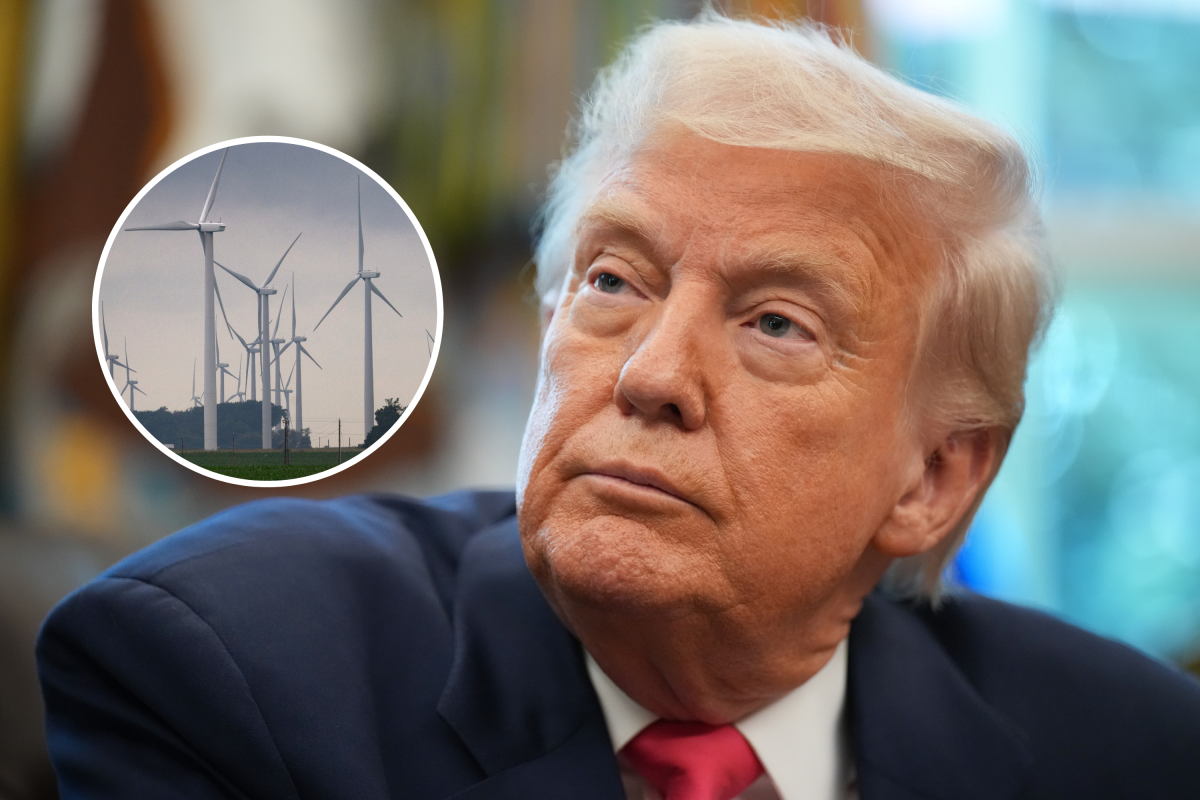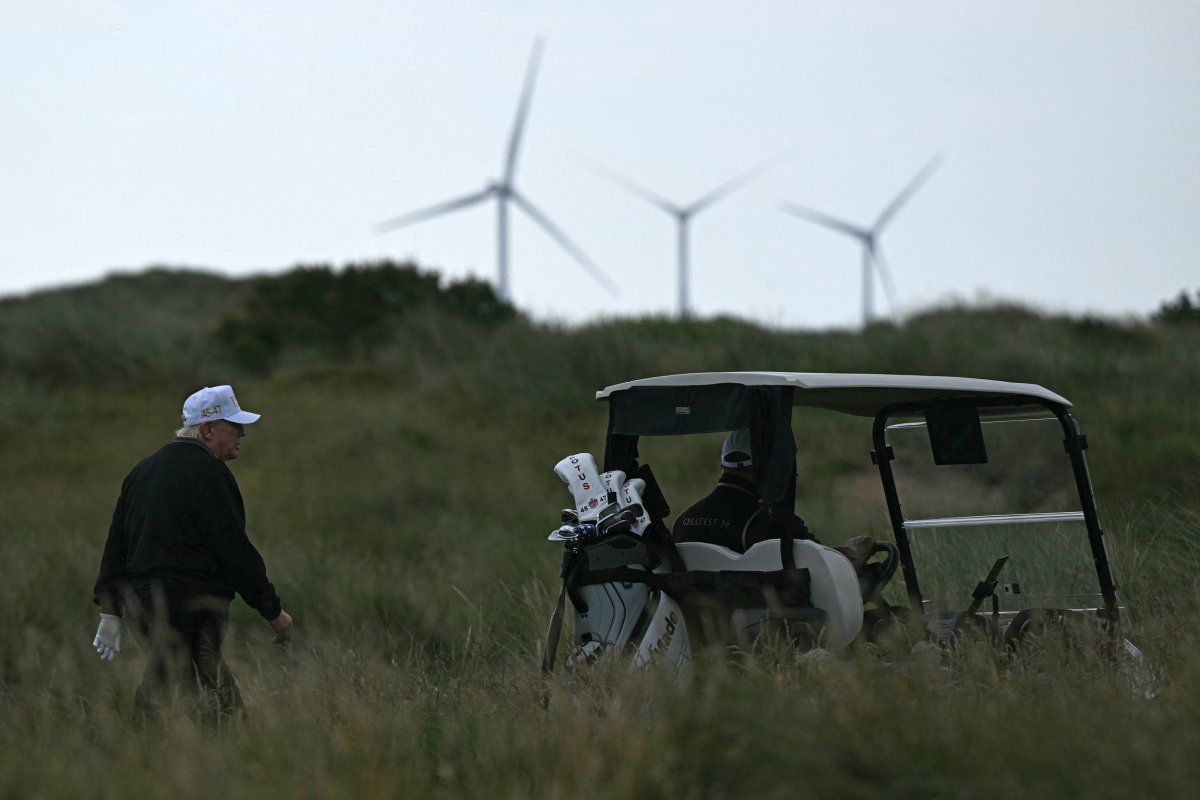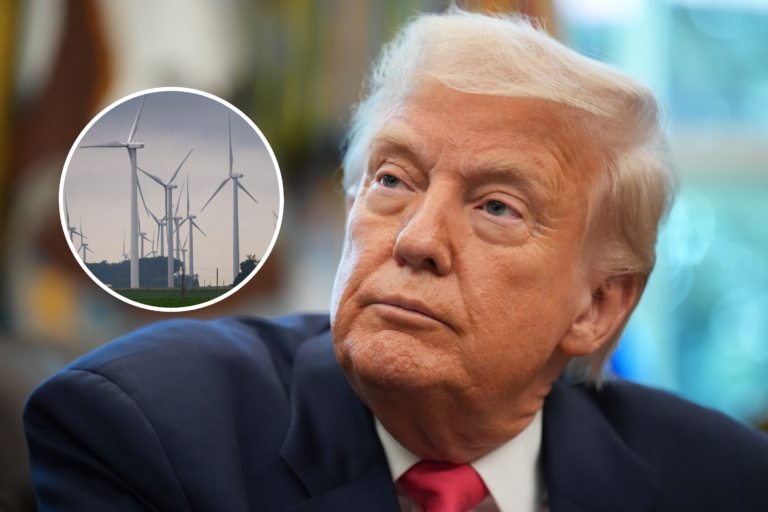President Donald Trump launched a fresh attack on windmills on Wednesday, again calling the renewable energy source inefficient and expensive, just a day after his administration unveiled new tariffs on wind turbines.
“Any State that has built and relied on WINDMILLS and SOLAR for power are seeing RECORD BREAKING INCREASES IN ELECTRICITY AND ENERGY COSTS,” the president posted to Truth Social on Wednesday, before calling these forms of renewables “THE SCAM OF THE CENTURY!”
On Tuesday, Trump’s Department of Commerce announced it would be expanding the scope of the Section 232 tariffs on steel and aluminum—doubled to 50 percent in June—to include 407 new product categories, including wind turbines as well as their “parts and components.”
“As a result, the steel and aluminum content of these products will be subject to a duty rate of 50 percent,” the department said in its announcement.
Newsweek contacted the Commerce Department via email for further comment on the expanded tariff list.
Why It Matters
Trump has frequently railed against wind power projects on economic, environmental and aesthetic grounds—dubbing them the “worst form of energy, the most expensive form of energy” during a recent press conference. In addition to such criticisms, Trump has paused federal wind permits while ending tax credits that had supported renewable developments in the U.S., which experts believe could threaten the construction of these projects and the broader diversification of America’s energy portfolio.
What To Know
In addition to the latest criticism, Trump attacked windmills as “stupid and ugly” in a Tuesday Truth Social post, before blaming them for energy bills rising in New Jersey.
Trump provided no sources linking renewable power to the state’s electricity prices or tying states’ reliance on wind and solar to “record-breaking” cost hikes. According to the most recent estimates from the U.S. Energy Information Administration, renewable sources accounted for only around 8 percent of New Jersey’s total generation in 2023, though the state aims to increase this to 50 percent by the end of the decade.
Electricity costs have surged in recent months. According to the latest Consumer Price Index (CPI) from the Bureau of Labor Statistics (BLS), average electricity prices were 5.5 percent higher in July compared to a year prior. This has been attributed in part to surging loads from artificial intelligence data centers, as well as outmoded energy infrastructure.
Renewable energy experts who spoke to Newsweek previously also believe provisions in the One Big Beautiful Bill Act, signed into law by President Trump on July 4, could eventually lead to even higher costs as planned projects are postponed or abandoned.

Scott Olson / Andrew Harnik/Getty Images
While not directly tied to Trump’s latest attack on windmills, the Commerce Department’s announcement of a tariff hike on wind turbines could hold implications for those companies seeking to set up wind projects on U.S. soil.
“Some of these goods are composed of steel and aluminum. Without these tariffs steel and aluminum products could be imported to the US at a low tariff rate,” said Christopher M. Meissner, professor of economics, professor of economics at U.C. Davis. “In principle, this is an attempt to close loopholes and to direct producer demand for steel and aluminum to American producers.”
“Whatever the motivation, the end result, as is usual with such tariffs, will likely be that the cost of renewable energy coming from wind turbines will be higher in the American market,” he told Newsweek.
In addition to wind turbines, the Commerce Department will be hiking steel and aluminum tariffs for hundreds of goods, including mobile cranes, bulldozers, and railcars.
The announcement followed a months-long comment period, during which outside parties were able to submit requests for products to be subject to the Section 232 duties. One of these came from the Wind Tower Trade Coalition, a group representing domestic manufacturers of utility-scale wind towers. The group requested that foreign-sourced wind turbines and towers be subject to the Section 232 tariffs as “imports of these derivative steel products threaten to impair U.S. national security.”
“Rising U.S. imports of low-priced wind towers have already caused significant harm to the domestic steel mill industry,” the group said. “Specifically, these imports have forced domestic wind tower producers to purchase imports rather than domestic steel mill products, resulting in fewer sales for domestic steel mills.”

More
Brendan Smialowski/AFP via Getty Images
Alan Sykes, professor of international law and diplomacy at Stanford University, told Newsweek that the process for choosing what products to subject to tariffs “is not entirely transparent and is no doubt influenced by political considerations, which may include issues other than just the interests of U.S. manufacturers.”
Don Graves, who served as Deputy Commerce Secretary during the Joe Biden administration, called the list of new tariffed products “quite something” and said that the Commerce Department would have been able to exempt wind turbines if it had wished.
“Commerce is able to make very discrete decisions on specific categories of products as detailed in the Harmonized Tariff Schedule of the United States (HTSUS) codes,” he told Newsweek. “I think it is clear that the current Administration has real problems understanding the value of renewable energy, our leadership in clean energy production and American energy sustainability.”
What People Are Saying
Under Secretary of Commerce for Industry and Security Jeffrey Kessler said on Tuesday: “Today’s action expands the reach of the steel and aluminum tariffs and shuts down avenues for circumvention – supporting the continued revitalization of the American steel and aluminum industries.”
President Donald Trump, during a meeting with U.K. Prime Minister Keir Starmer in Scotland last month, said: “Wind is the most expensive form of energy. And it destroys the beauty of your fields and your plains and your waterways. And look, look out there — there’s no windmills. But if you look in another direction, you see windmills. If, when we go to Aberdeen, you’ll see some of the ugliest windmills you’ve ever seen. They’re the height of a 50-story building. And you can take a thousand times more energy out of a hole in the ground… It’s called oil and gas.”
Former Deputy Commerce Secretary Don Graves told Newsweek: “A significant factor in US economic success has been the clarity, transparency and predictability in our policies and laws that workers, businesses, innovators and investors use to make long-term decisions. These new tariffs are almost certainly political and will lead to significant increases in costs to American businesses and consumers.”
Christopher M. Meissner, professor of economics at U.C. Davis, told Newsweek: “These [tariffs] add enormous complexity to the business environment. What is likely is that consumer prices will go up, costs for ‘downstream’ producers or users of the covered products will go up, and employment in these industries will grow more slowly. Some local American producers of competing products may see a rise in order flow and revenue. It will be interesting to watch the adjustment process – moving workers from the downstream industries that are hurt to the protected industries that are benefitting. What we have learned from the past is that this process or adjustment can be slow and it is likely to be economically costly.”
What Happens Next?
In addition to steel and aluminum, the Commerce Department has launched Section 232 investigations into the impact of other imports on U.S. national security, potentially paving the way for tariff hikes on semiconductors, pharmaceuticals and other goods.


